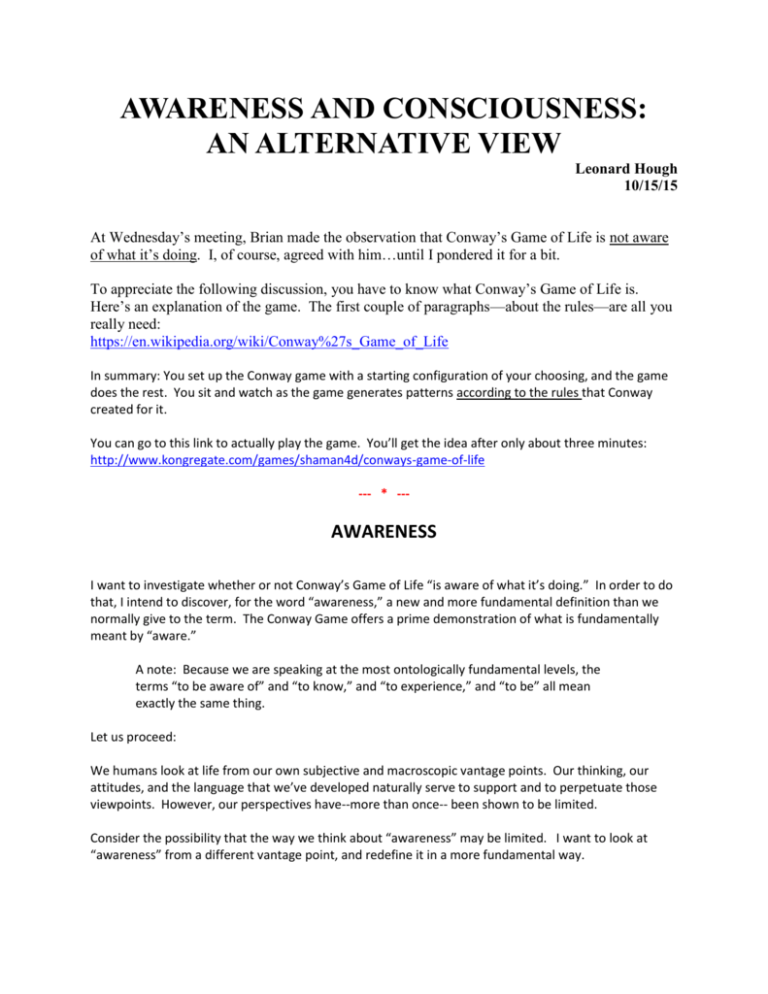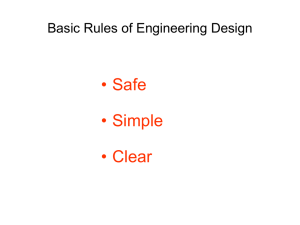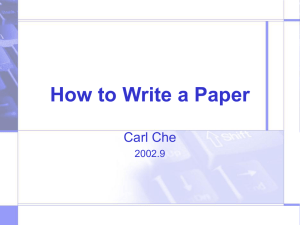awareness and consciousness
advertisement

AWARENESS AND CONSCIOUSNESS: AN ALTERNATIVE VIEW Leonard Hough 10/15/15 At Wednesday’s meeting, Brian made the observation that Conway’s Game of Life is not aware of what it’s doing. I, of course, agreed with him…until I pondered it for a bit. To appreciate the following discussion, you have to know what Conway’s Game of Life is. Here’s an explanation of the game. The first couple of paragraphs—about the rules—are all you really need: https://en.wikipedia.org/wiki/Conway%27s_Game_of_Life In summary: You set up the Conway game with a starting configuration of your choosing, and the game does the rest. You sit and watch as the game generates patterns according to the rules that Conway created for it. You can go to this link to actually play the game. You’ll get the idea after only about three minutes: http://www.kongregate.com/games/shaman4d/conways-game-of-life --- * --- AWARENESS I want to investigate whether or not Conway’s Game of Life “is aware of what it’s doing.” In order to do that, I intend to discover, for the word “awareness,” a new and more fundamental definition than we normally give to the term. The Conway Game offers a prime demonstration of what is fundamentally meant by “aware.” A note: Because we are speaking at the most ontologically fundamental levels, the terms “to be aware of” and “to know,” and “to experience,” and “to be” all mean exactly the same thing. Let us proceed: We humans look at life from our own subjective and macroscopic vantage points. Our thinking, our attitudes, and the language that we’ve developed naturally serve to support and to perpetuate those viewpoints. However, our perspectives have--more than once-- been shown to be limited. Consider the possibility that the way we think about “awareness” may be limited. I want to look at “awareness” from a different vantage point, and redefine it in a more fundamental way. “Awareness” in the Conway game: We say that the Conway game is not aware of what it’s doing. In fact, we think of the game as being not “aware” at all. But…what is awareness? Notice, as you watch the game proceed, that the patterns unfold before you in an ordered and beautiful way. It is exactly as though the game WERE aware of the rules—as if the game DOES know what it’s doing. I say that the patterns that the game produces are the direct proof that the game is aware—in some unfamiliar sense of the word-- of the rules. In what sense of the word can we call this “awareness?” What kind of awareness is this? Now, I will not claim that the game is conscious in any way. It exhibits, in no sense, “conscious awareness.” But, I do claim that the game is most certainly “aware” of what it’s doing as it creates the patterns. In fact, the kind of awareness that the game exhibits is “awareness” in the most fundamental sense. By that, I mean that the patterns that you watch unfold are the direct embodiment of the rules. Further, I claim that the ONLY way to be truly “aware” of something is to be the direct embodiment of that something. Any other type of awareness is secondary to direct embodiment, and is thus a lesser form of awareness. “Awareness” in the Human: In the same way that the Conway game is the direct embodiment of a set of rules, people are also the direct embodiment of a certain set of rules. The rules of which people are the direct embodiment are these: the fundamental laws of the universe—i.e., the laws of nature. The laws of nature are directly embodied in people, and therefore, people have the most fundamental type of awareness of those laws. The fundamental patterns that humans produce are existence—ontological existence. To offer you a grasp of what the rules are, and in what way humans directly embody those rules, I offer the following:. The rules of the game are the rules of existence. They are the so-called “laws of nature.” These are the fundamental influences of the universe. Some of my favorite examples are: the push and pull of the fundamental forces, the Principle of Least Action (https://en.wikipedia.org/wiki/Principle_of_least_action), natural flow along geodesic paths (https://en.wikipedia.org/wiki/Geodesic), natural flow down chemical gradients, metabolism (https://en.wikipedia.org/wiki/Metabolism), and homeostasis (https://en.wikipedia.org/wiki/Homeostasis). You are free to add some of your own favorites. I say that people embody the rules because the very ontological cloth of our being is woven out of those natural laws. Every cell and every fiber of our being is, literally, made up of those influences of nature. Each molecule; every proton, neutron, and electron that make up our bodies are part of the laws of nature. They flow along chemical gradients; they follow the natural geodesic paths; they innately embody the Principle of Least Action; they are made of the fundamental forces; they embody metabolism and homeostasis. People don’t merely follow the rules or move along the prescribed pathways: the elements that make up our bodies ARE the rules, in action. They are the direct embodiment of the laws of the universe. This direct embodiment of the rules in action is the purest, and most fundamental, and primordial definition of the notion of “awareness.” It is the very essence of awareness. Any other type of awareness is secondary to direct embodiment, and is thus a lesser form of awareness. Consciousness—A Lesser Form: It is important to note that this purest level of awareness is not conscious activity. Neither is it unconscious activity, sub-conscious activity, reason, intuition, emotion, feeling, nor thought. Our embodied awareness is far more fundamental than are those things. It is the fundamental stuff of which those things are constructed. Consciousness--being merely a construct of our primordial, innate, embodied awareness--does not, itself, directly embody the rules. Because it does not directly embody the rules, our conscious awareness is often puzzled about what’s going on. It seeks answers; it generates models; it bumps up against infinities, singularities, and paradoxes. In short, our conscious awareness is continually in what Heidegger called a “deficient mode” of existence. I claim that these deficient patterns of confusion, perplexity, and paradox that our consciousness produces are the direct proof that consciousness is NOT fundamentally aware of the laws of nature. Consciousness does not directly embody those laws. It is not directly attuned to or aligned with the laws of nature. Therefore, conscious is a secondary—not a fundamental-- aspect of reality. Appendix: I have used the Conway Game and I have used humans as my examples to explain fundamental awareness. But, it is most definitely NOT only humans that directly embody the laws of nature. The laws of nature are directly embodied in the other animals, in the plants, in bacteria, the water, the stones, the planets, and the galaxies. All of the preceding discussion applies to them as well.






